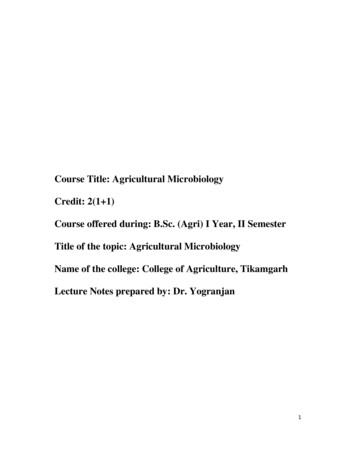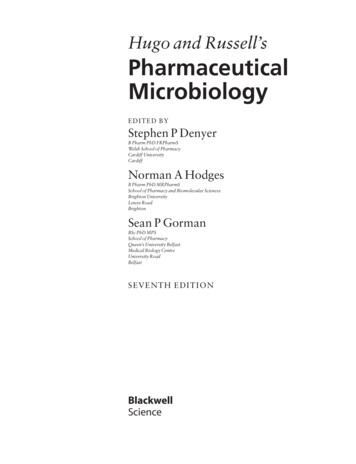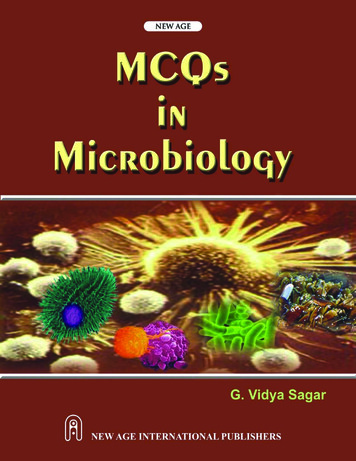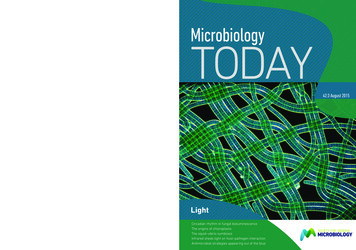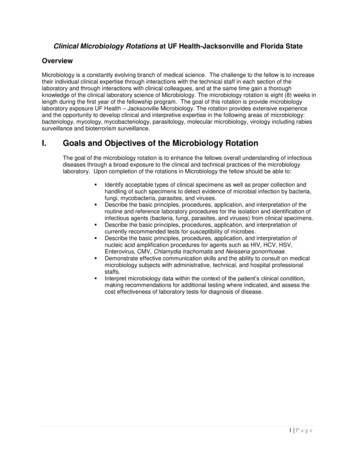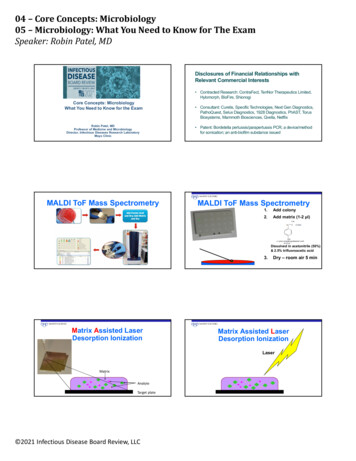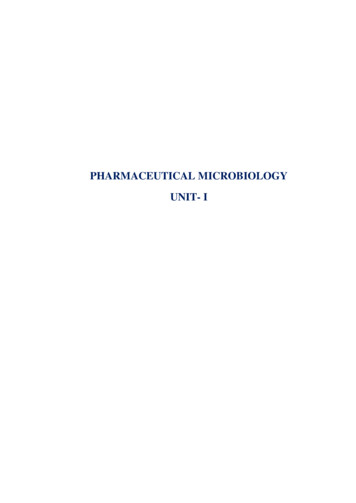
Transcription
PHARMACEUTICAL MICROBIOLOGYUNIT- I
Introduction, history of microbiology, its branches, scope and its importance. Introduction to Prokaryotes and Eukaryotes. Study of:o Ultra-structureandmorphologicalo Isolation and preservation methods forclassification of bacteriapure cultureso Nutritional requirements, raw materialso Cultivation of anaerobesused for culture mediao Quantitative measurement of bacterialgrowth (total and viable count)o Physical parameters for growtho Growth curve Study of different types of:o Phase contrasto Dark field microscopyo Electron microscopymicroscopyINTRODUCTION [1, 2]A microbe, or microorganism, is a microscopic organism that comprises either a single cell(unicellular); cell clusters; or multi cellular, relatively complex organisms.Microbiology: The detailed study of microorganisms.Microorganisms are very diverse; they include: Bacteria Microscopic plants (green algae) Fungi Animals such as rotifers and planarians. Algae Some microbiologists also include viruses. Protozoa Most microorganisms are unicellular, but this is not universal, since some multicellular organismsare microscopic. Some unicellular protists and bacteria, like Thiomargarita namibiensis, are macroscopicand visible to the naked eye. Most importantly, these organisms are vital to humans and the environment, as they participate inthe Earth’s element cycles, such as the carbon cycle and the nitrogen cycle. Microorganisms live in all parts of the biosphere:o deep inside the rocks, withino watero on the ocean floorthe Earth’s crusto soilo in the atmosphereo hot springsHISTORY OF MICROBIOLOGY [1] Scientific evidence suggests that life began on Earth some 3.5 billion years ago. Since then, life has evolved into a wide variety of forms, which biologists have classified intoa hierarchy of taxa. Some of the oldest cells on Earth are single-cellEarly history of microbiologyHistorians are unsure who made the first observations of microorganisms.Antonie van Leeuwenhoek (1632–1723): Father of microbiology” Father of bacteriology and protozoology (protistology), fromHolland Developed microscope in 1673 and observed microorganisms, which he called animalculesand made one of the most important contributions to biology. Revealed accurate descriptions of protozoa, fungi, and bacteria.Robert Hook: Developed compound microscope and observed first cork cell.DIFFERENT ERA IN HISTORY OF MICROBIOLOGY1. Discovery Era3. Golden Era (1850 to 1915)2. Transition Era4. Modern Era
Abiogenesis vs. Biogenesis Theory of spontaneous generation, which stated that microorganisms arise from lifeless mattersuch as beef broth. An English cleric named John Needham advanced spontaneous generation. This theory was disputed by Francesco Redi, who showed that fly maggots do not arise fromdecaying meat (as others believed) if the meat is covered to prevent the entry of flies. Lazzaro Spallanzani disputed the theory by showing that boiled broth would not give rise tomicroscopic forms of life. Pasteur had to disprove spontaneous generation to sustain his theory, and he therefore devised aseries of swan‐necked flasks filled with broth. He left the flasks of broth open to the air, but the flasks had a curve in the neck so thatmicroorganisms would fall into the neck, not the broth. The flasks did not become contaminated. Pasteur's experiments put to rest the notion of spontaneous generation. Pasteur, thus in 1858 resolved the controversy of spontaneous generation versus biogenesis andproved that microorganisms are not spontaneously generated from inanimate matter but arisefrom other microorganisms. John Tyndall (1820–1893): An English physicist, Gave a final blow to spontaneousgeneration in 1877. He conducted experiments in an aseptically designed box to prove that dust indeed carried thegerms. He demonstrated that if no dust was present, sterile broth remained free of microbial growth forindefinite period even if it was directly exposed to air. He discovered highly resistant bacteria structure, later known as endospore. Prolonged boiling or intermittent heating was necessary to kill these spores, to make the infusioncompletely sterilized, a process known as Tyndallisation.Chicken cholera experiment In 1880, Pasteur found that Chicken cholera germs from an old culture that had been around forsome time lost their ability to transmit the disease The inoculated chickens did not die. He repeated what he had done but with a fresh culture of chicken cholera germs. Pasteur reasoned that a new culture would provide more potent germs. He found a way of producing the resistance without the risk of the disease. Two groups of chickens were inoculated; one that had been given the old culture and one groupthat had not. Those chickens that had been given the old culture survived, those that had not died. The chickens that had been inoculated with the old culture had become immune to chickencholera. Pasteur believed that their bodies had used the weaker strain of germ to form a defense againstthe more powerful germs in the fresher culture.Koch’s four postulates (1890): The organism causing the disease can be found in sick individuals but not in healthy ones. The organism can be isolated and grown in pure culture. The organism must cause the disease when it is introduced into a healthy animal. The organism must be recovered from the infected animal and shown to be the same as theorganism that was introduced. The combined efforts of many scientists and most importantly Pasteur and Robert Kochestablished the Germ theory of disease. The idea that invisible microorganisms are the cause of disease is called germ theory.The steps of Koch's postulatesa) Microorganisms are observed in a sickd) The animal develops the disease.e) The organisms are observed in theanimalsick animalb) Cultivated in the lab.f) Re-isolated in the lab.c) The organisms are injected into a healthyanimal
Edward Jenner (1749-1823): An English physician was the first to prevent small pox. Impressed by the observation that countryside milk maid who contacted cowpox (Cowpox is amilder disease caused by a virus closely related to small pox) while milking were subsequentlyimmune to small pox. In1796 he proved that inoculating people with pus from cowpox lesions provided protectionagainst small pox. Jenner in 1798 published his results on 23 successful vaccinators. Eventually this process was known as vaccination, based on the latin word ‘Vacca’ meaning cow. He called the attenuated cultures as vaccines and the process as vaccination. Thus the use of cow pox virus to protect small pox disease in humans became popular replacingthe risky technique of immunizing with actual small pox material. Jenner’s experimental significance was realized by Pasteur who next applied this principle to theprevention of anthrax and it worked. Encouraged by the successful prevention of anthrax by vaccination, Pasteur marched aheadtowards the service of humanity by making a vaccine for hydrophobia or rabies (a diseasetransmitted to people by bites of dogs and other animals). As with Jenner’s vaccination for small pox, principle of the preventive treatment of rabies alsoworked fully which laid the foundation of modern immunization programme against manydreaded diseases like diphtheria, tetanus, pertussis, polio and measles etc.Lord Joseph Lister (1827-1912): English surgeon is known for his notable contribution to the antiseptic treatment for theprevention and cure of wound infections. Lister concluded that wound infections too were due to microorganisms. In 1867, he developed a system of antiseptic surgery designed to prevent microorganisms by theapplication of phenol. He also devised a method to destroy microorganisms in the operation theatre by spraying a finemist of carbolic acid into the air, thus producing an antiseptic environment. He first to introduce aseptic techniques for control of microbes by the use of physical andchemical agents which are still in use today. Because of this notable contribution, Joseph Lister is known as the Father of Antisepticsurgery.Sir Alexander Fleming (Scottish physician and bacteriologist): The credit for the discovery of thefirst ‘wonder drug’ penicillin in 1929 goes to Fleming.Dmitri Ivanovsky and Virus: Louis Pasteur was unable to find a causative agent for rabies and speculated about a pathogen toosmall to be detected by microscopes. In 1884, the French microbiologist Charles Chamberland invented the Pasteur-Chamberlandfilter with pores small enough to remove all bacteria from a solution passed through it. In 1892, the Russian biologist Dmitri Ivanovsky used this filter to study what is now known asthe tobacco mosaic virus: crushed leaf extracts from infected tobacco plants remained infectiouseven after filtration to remove bacteria. Ivanovsky suggested the infection might be caused by a toxin produced by bacteria, but did notpursue the idea. At the time it was thought that all infectious agents could be retained by filters and grown on anutrient medium—this was part of the germ theory of disease. In 1898, the Dutch microbiologist Martinus Beijerinck repeated the experiments and becameconvinced that the filtered solution contained a new form of infectious agent. He observed that the agent multiplied only in cells that were dividing, but as his experiments didnot show that it was made of particles, he called it a contagium vivum fluidum (soluble livinggerm) and re-introduced the word virus. In the early 20th century, the English bacteriologist Frederick Twort discovered a group ofviruses that infect bacteria, now called bacteriophages (or commonly 'phages'). The development of bacterial resistance to antibiotics has renewed interest in the therapeutic useof bacteriophages.
In 1931, when the American pathologist Ernest William Goodpasture and Alice Miles Woodruffgrew influenza and several other viruses in fertilised chicken eggs. The first images of viruses were obtained upon the invention of electron microscopy in 1931 bythe German engineers Ernst Ruska and Max Knoll. In 1935, American biochemist and virologist Wendell Meredith Stanley examined the tobaccomosaic virus and found it was mostly made of protein. A short time later, this virus was separated into protein and RNA parts. The second half of the 20th century was the golden age of virus discovery and most of thedocumented species of animal, plant, and bacterial viruses were discovered during these years.SCOPE OF MICROBIOLOGY [1] Microorganisms are present everywhere on earth which includes humans, animals, plants andother living creatures, soil, water and atmosphere. Microbes can multiply in all three habitats except in the atmosphere. Together their numbers far exceed all other living cells on this planet. Microorganisms are relevant to all of us in a multitude of ways. The influence of microorganism in human life is both beneficial as well as detrimental also. For example microorganisms are required for the production of bread, cheese, yogurt, alcohol,wine, beer, antibiotics (e.g. penicillin, streptomycin, chloromycetin), vaccines, vitamins, enzymesand many more important products. Microorganisms are indispensable components of our ecosystem. Microorganisms play an important role in the recycling of organic and inorganic material throughtheir roles in the C, N and S cycles, thus playing an important part in the maintenance of thestability of the biosphere. There is vast scope in the field of microbiology due to the advancement in the field of scienceand technology. The scope in this field is immense due to the involvement of microbiology in many fieldslike medicine, pharmacy, diary, industry, clinical research, water industry, agriculture,chemical technology and nanotechnology. Microorganisms also have harmed humans and disrupted societies over the millennia. Many microbes spoil food and deteriorate materials like iron pipes, glass lenses, computer chips,jet fuel, paints, concrete, metal, plastic, paper and wood pilings. The study of microbiology contributes greatly to the understanding of life throughenhancements and intervention of microorganisms.ROLE AND APPLICATION OF MICROBIOLOGY IN DIFFERENT FIELDS [2]:Table 1: Role and application of microbiology in different fields Study the synthesis of antibiotics and toxins, microbial energy production,Microbialmicrobial nitrogen fixation, effects of chemical and physical agents onphysiology andmicrobial growth and survival etc.BiochemistryImmunology Immunology: The study of immune system which protect the body fromandpathogens) Deals with the identification and measures to cure diseases of human andMedicineanimals which are infectious to them. They have also provided us with the means of their control in the form ofvaccine, antibiotics and other medically important drugs. Study of genetic information and how it regulated the development andMolecularfunction of cells and organisms.biology New genes can be inserted into plants and animals.Microbial Genetic engineering: microbes used to make hormones (insulin, human growthgeneticshormone), vaccine, antibiotics, and interferon and many other useful productsandfor human being.Genetic Development of new efficient microbial strains to synthesize useful products.engineering
AgricultureFood scienceIndustrialmicrobiologyMicrobialecology The influence of microbes on agriculture; the prevention of the diseases thatmainly damage the useful crops. Microorganisms have been used to produce food, from brewing and winemaking, Use of microbes to produce cheese, yoghurt, pickles and beer. Microbes are also responsible for food spoilage so their studt helps in theprevention of spoilage of food and food borne diseases. Involves use of microbes to produce antibiotics, steroids, alcohol, vitamins andamino acids etc. Bio-geochemical cycles: bioremediation (clean up the environment of toxiccompounds) to reduce pollution effects Microbes are responsible for the cycling of carbon, nitrogen phosphorus(geochemical cycles) Maintain ecological balance on earth Maintain soil fertility and may also beProkaryotes and Eukaryotes [1]: On the basis of genetic materials enclosed by a nuclear envelope,cells are divided into prokaryotes and eukaryotes. Prokaryotes don’t have membrane boundorganelles where as eukaryotes have.Table 2: Difference between eukaryotes and prokaryotesProkaryotic CellEukaryotic cellSize is 0.1- 5.0 umSize is 5-100 umNucleus is absentNucleus is presentMembrane bound nucleus absent.Membrane bound Nucleus is present.One chromosome is presentMore than one number of chromosomes is present.UnicellularMulticellularLysosomes and Peroxisomes absentLysosomes and Peroxisomes presentMicrotubules absentMicrotubules presentEndoplasmic reticulum absentEndoplasmic reticulum presentMitochondria absentMitochondria presentCytoskeleton absentCytoskeleton presentRibosomes smallerRibosomes largerVesicles presentVesicles presentGolgi apparatus absentGolgi apparatus presentChloroplasts absent; chlorophyll scatteredin the cytoplasmChloroplasts present in plantsVacuoles absentVacuoles absentPermeability of Nuclear membrane is notpresentPermeability of Nuclear membrane is selectiveSexual reproduction is absentSexual reproduction is presentEndocytosis and exocytosis are absent.Endocytosis and exocytosis occurredIt may have pili and fimbriae.Pili and fimbriae are absentTranscription occurs in the cytoplasmTranscription occurs inside the nucleus.
ULTRA-STRUCTURE OF BACTERIA (bacteria-singular; bacterium: plural) [1, 2]: “Bacteria are unicellular prokaryotic organism where the organisms lack a few organelles and atrue nucleus”. Bacterial cell have simpler internal structure, which lacks all membrane bound cell organelles suchas mitochondria, lysosome, golgi, endoplasmic reticulum, chloroplast and true vacuole etc. All the action takes place in the cytosol or cytoplasmic membrane Bacteria also lacks true membrane bound nucleus and nucleolus. The bacterial nucleus is known asnucleoid. Most bacteria possess peptidoglycan, a unique polymer that makes its synthesis peptidoglycan is a good target for antibiotics. Protein synthesis takes place in the cytosol with structurally different ribosome’sSize 0.2 µm – 0.1 mm Most 0.5 – 5.0 µmShapeArrangement Coccus (cocci) Clusters rod (bacillus, bacilli) Tetrads spiral shapes (spirochetes; Pairsspirillum, spirilla) chains filamentous and various oddshapes.Structures Outside the Cell WallStructures Inside the Cell Wall Capsule Cell wall Flagella Cytoplasmic membrane Pili Nucleoid Sheath Mesosome Prostheca Ribosome Stalks cytoplasmStructure Outside the Cell WallCapsule: Capsule is 0.2µm thick viscus layer outerlayer to the cell wall. Capsule is 98% water and 2% polysaccharideor glycoprotein/ polypeptide or both. There are two types of capsule.i. Macro-capsule: thickness of 0.2µm ormore, visible under light microscopeii. Microcapsule: thickness less than 0.2µm,visible under Electron microscope Capsule is very delicate structure. It can be removed by vigorous washing. Capsule is most important virulence factor of bacteria.Function of capsule:o It helps in attachments as well as it prevent the cell from desiccation and drying.o Capsule resist phagocytosis by WBCsFlagella It is 15-20 nm filaments (hair like helical structure) extending from cytoplasmic membrane toexterior of the cell. The location of the flagella depends on bacterial species as polar situated at one or both endswhich swims in back and forth fashion and lateral at along the sides. The parts of flagella are the filament, hook and the basal body. Filament is external to cell wall and is connected to the hook at cell surface, the hook and basalbody are embedded in the cell envelope. Hook and filament is composed of protein subunits called as flagellin.
It is composed of flagellin protein (globular protein) and known as H antigen.Flagellin is highly antigenic and functions in cell motility.Flagellin is synthesized within the cell and passes through the hollow centre of flagella.The arrangement of flagella may be described asi. Monotrichous– single flagella on one sideiii. Amphitrichous–single or tuft on both sidesii. Lophotrichous– tuft of flagella on one sideiv. Peritrichous–surrounded by lateral flagellFunction of Flagella Flagella are fully responsible for the bacterial motility. Deflagellation by mechanical means renders the motile cells immotile. The apparent movement of the bacterial cell usually takes place by the rotation of the flagellaeither in the clockwise or anticlockwise direction along its long axis. Bacterial cell possesses the inherent capacity to alter both the direction of rotation and the speed;besides, the meticulous adjustment of frequency of ‘stops’ and ‘starts’ by the appropriatemovement of the flagella.Pili / Fimbriae Hair-like proteinaceous structures that extend from the cell membrane to external environment arepili which are otherwise known as fimbriae. They are thinner, shorter and more numerous than flagella and they do not function in motility. There are two types of pili namely:i. Non-sex pili (Common pili) eg. fimbriae. The fimbriae are antigenic and mediate theiradhesion which inhibits phagocytosisii. The sex pili help in conjugation.Cell Walls Beneath the external structures is the cell wall. Animal cells do not have a cell wall outside the cell membrane. Plant cells and fungal cells do have a cell wall. Most prokaryotic cells like bacteria (almost all) have a cell wall. They are essential structures in bacteria. A bacterium is referred as a protoplast when it is without cell wall. Cell wall may be lost due to the action of lysozyme enzyme, which destroys peptidoglycan.This cell is easily lysed and it is metabolically active but unable to reproduce. A bacterium with a damaged cell wall is referred as spheroplasts. It is caused by the action of toxic chemical or an antibiotic, they show a variety of forms andthey are able to change into their normal form when the toxic agent is removed, i.e. whengrown on a culture media. They are made of chemical components, which are found nowhere else in nature. Gram stain invented by Hans Christian Gram Divides Eubacteria into two main groups based on stain. Gram-positive cell wall is thick homogeneous monolayer Gram-negative cell wall is thin heterogeneous multilayer Correlates with two types of cell wall architecture.Gram Positive Cell wall Composed of peptidoglycan. Mucopeptide (peptidoglycan or murien) formed by N acetyl glucosamine and N acetylmuramic acid alternating in chains, cross linked by peptide chains. Embedded in it are polyalcohol called Teichoic acids. Some are linked to Lipids and called Lipoteichoic acid. Lipotechoic acid link peptidoglycan to cytoplasmic membrane and the peptidoglycan givesrigidity.Structure and Function of Peptidoglycan Single bag-like, seamless molecule Composed of polysaccharide chains cross linked with short chains of amino acids: “peptido”and “glycan”. Peptidoglycan provides support and limits expansion of cell membrane Provides shape and structural support to cell
Resists damage due to osmotic pressureProvides some degree of resistance todiffusion of molecules Lysozyme found in secretions cutspeptidoglycan Antibiotic penicillin prevents cross linking Cells in isotonic medium are not harmed Gram-positive cell walls contain teichoic acids lipoteichoic acid. Polymer of phosphate and ribitol or glycerol Lipoteichoic acid covalently attached to membrane lipids. Major contributor to negative charge of cell exterior. Appears to function in Ca binding Teichoic acids are thought to stabilize the Gram positive cell wall and may be used inadherence.GRAM-NEGATIVE CELL WALL The cell walls of Gram-negative bacteria are more chemically complex, thinner and lesscompact. Gram-negative bacteria have relatively thin cell wall consisting of few layers of peptidoglycanand a outermembrane. Peptidoglycan comprises 5-10% of the wall material (thickness 2-6 nm). Outer membrane composed of: lipoprotein, phospholipid and lipopolysaccharide.1. Outer Membrane (Outer Lipopolysaccharide and Phospholipids layer) Outer membrane isfound only in Gramnegative bacteria. It functions as aninitial barrier to theenvironment. It protects the cellsfrom permeabilityby many substancesincluding penicillinand lysozyme. It is the location oflipopolysaccharide(endotoxin) which istoxic for animals. This is composed of:A. Lipopolysaccharide (LPS)B. Phospholipids
A. Lipopolysaccharide (LPS): Lipopolysaccharides are outer most part of Gram (-) bacterialcell wall, which acts as an endotoxin.Lipopolysaccharides,are composed of:o polysaccharides and lipid A (responsible for much of the toxicity of Gram -ve bacteria)o core polysaccharideo a terminal series of repeat units ( O antigen).B. Phospho-lipid of outer membrane (distinct from all other biological membranes): Its outer leaflet contains a lipopolysaccharides. This membrane has special channels (tiny holes or openings) called porins (consisting ofprotein molecules). Porins block the entrance of harmful chemicals and antibiotics, making Gram-ve bacteria muchmore difficult to treat than Gram ve cells.C. Lipoprotein: It cross-link the outer membrane and peptidoglycan layers.5 – 20%of the cell wall and is not the outermost layer, but lies between the plasma membrane and anouter membrane.2. PEPTIDOGLYCAN LAYER (Thin inner layer): Peptidoglycan makes up onlyPrimary function of the bacterial cell wall: To prevent the cell from expanding and eventually rupture or osmotic lysis of the cell protoplast. It is very rigid and gives shape to the cell. They may cause symptoms of disease in animals. They are the site of action of some of our most important antibiotics.CELL MEMBRANE/ CYTOPLASMIC MEMBRANE Lies beneath the cell wall and separating it from thecell cytoplasm. Completely encloses the bacterial cell protoplast Composed of 60% protein and 40% phospholipid 5-10 nm thick, elastic and semipermeable layer Composed of Phospholipid, proteins and enzymes.Phospholipid (20-30%): Form bi-layered structure inwhich proteins are embedded and has two parts:1. Hydrophilic head part 2. Hydrophobic tail part.Proteins (70-80%), which are of two types:1. peripheral proteins and 2, integralproteins Plasma membranes in bacteria are composed of phospholipids contains a polar groupattached to a 3 carbon glycerol back bone. Arranged as a bi-layer Two fatty acid chains (hydrophobic) dangling from the other carbons of glycerol. The phosphate end of the molecule is hydrophilic and is attracted to water. The fatty acids are hydrophobic. Phospholipids arrange themselves spontaneously in water: lipid “tails” inward; glycerol “heads”outward. The membrane proteins associate with both sides of the membrane, or may imbed in themembrane, or pass through the membrane.Functions of the Cytoplasmic Membrane Proteins in the cytoplasmic membrane have a variety of functions including transport and energytransformations. The plasma membrane is selectively permeable (control what moves into and out of cell). Osmotic or permeability barrier: the membrane is impermeable to molecules that are chargedor greater than molecular weight of 100
Energy generation: Location of the electron transport system (ETS) and the ATP synthsizingenzyme ATPase Specialized functions involving: cell wall synthesis, cell division and DNA replication.Mesosome The outer membrane of cytoplasm forms much coiled invagination called mesosome. The surface of mesosome has many respiratory enzymes, which takes part in respiration. It is absent in eukaryotic cells.Structure Inside the Cell wall: Cytoplasm and Cytoplasmic Constituents of Bacterial CellsCytoplasm:o This is a Colloidal system containing a variety of organic and inorganic solutes containing80% Water and 20% Salts, Proteins.o They are rich in ribosomes, DNA and fluid.Cytoplasmic Constituents of Bacterial Cells1. Geneticmaterials:2. Ribosomes Chromosome (DNA) Plasmids3.InclusionsGenetic Materials: In prokaryotes nucleus is not distinct. Nuclear membrane and nucleolus are absent. The genetic materials consists of DNA. DNA (deoxyribonucleic acid): This is the genetic material of the cell. It contains a single chromosome consisting of a circularDNA filament and haploid. They are highly coiled with intermixed polyamines andsupport proteins. The genetic material DNA is present in the cytoplasmwithout histon proteins. It can be replicated in a semi-conservative fashion andpassed on to progeny cells. Plasmids are extra circular DNA. The cytoplasmic carriers of genetic information are termed plasmids or episomes.Ribosome The procaryotic ribosome (L) is 70S in size, being composed of a 50S (large) subunit and aand 30S (small) subunit. The eucaryotic ribosome (R) is 80S in size and is composed of a 60Sand a 40S subunit. Ribosomes are made of two subunits, a large subunit and a small subunit. Each subunit ismade up of RNA and various proteins.Function of Ribosome: Ribosomes function in protein synthesis. Amino acids are assembled into proteins according to the genetic code on the surfaces ofribosomes during the process of translation.CLASSIFICATION OF BACTERIA [2]:Bacteria can be classified into various categories based on their features and characteristics.The classification of bacteria is mainly based on the following characters:1. Morphological Classification (Based on Shape)2. Composition of the cell wall3. Mode of respiration4. Mode of nutrition
Morphological Classification (Based on Shape) Bacteria and Archaea are classified by direct examination with the light microscope according totheir morphology and arrangement. The basic morphologies are:1. Spheres (coccus)2. Round-endedcylinders(bacillus).3. Helically twisted cylinders(spirochetes)4. Cylinders curved in oneplane (selenomonads)5. Unusualmorphologies(such as the square, flatbox-shaped cells of thearchaean genus). Arrangementsincludepairs, tetrads, clusters,chains and palisades.1. Coccus (Pleural – Cocci):Spherical bacteria may occur in pairs(diplococci) ingroupsoffour(tetracocci) in grape-like clusters (Staphylococci) in chains (Streptococci) in cubical arrangements of eight or more (sarcinae).Example: Staphylococcus aureus, S. pyogenes.2. Bacillus (Pleural–Bacilli): Rod-shaped bacteria; for example – Bacillus cereus, Clostridiumtetani. generally occur singly but may occasionally be found in pairs (diplo-bacilli) chains (streptobacilli).3. Spirillum (Pleural–Spirilla): Spiral-shaped bacteria. Spiral bacteria can be sub-classified on the basis of number of twists per cell, cell thickness,cell flexibility, and motility.o Spirillao Spirocheteso vibriosFor example – Spirillum, Vibrio, Spirochete species.4. Bacteria have Other Shapes Such as: Coccobacilli – Elongated spherical or ovoid form. Filamentous – Bacilli that occur in long chains or threads.NUTRITIONAL REQUIREMENTS, RAW MATERIALS USED FOR CULTURE MEDIA [3]Chemical Requirements: Carbon, Nitrogen, Sulfur, and Phosphorus, other elements, traceelements and oxygen.Carbon: Structural backbone of all organic compounds and Makes up 50% of dry weight of cell. Chemoheterotrophs: Obtain carbon from their energy source: lipids, proteins, andcarbohydrates. Chemoautotrophs and Photoautotrophs: Obtain carbon from carbon dioxide.Nitrogen: It makes up 14% of dry cell weight and used to form amino acids, DNA, and RNA.Sources:o Protein: Most bacteriao Nitrogen gas (N2): Directly from atmosphere.o Ammonium: Found in organic mattero Nitrates: Salts that dissociate to give NO3-
Sulfur: Used to form proteins and some vitamins (thiamin and biotin).Sources:o Protein: Mostlyo Hydrogen sulfideo SulfatesPhosphorus: Used to form DNA, R
HISTORY OF MICROBIOLOGY [1] Scientific evidence suggests that life began on Earth some 3.5 billion years ago. Since then, life has evolved into a wide variety of forms, which biologists have classified into a hierarchy of taxa. Some of the oldest cells on Earth are single-cell Early history of microbiology

